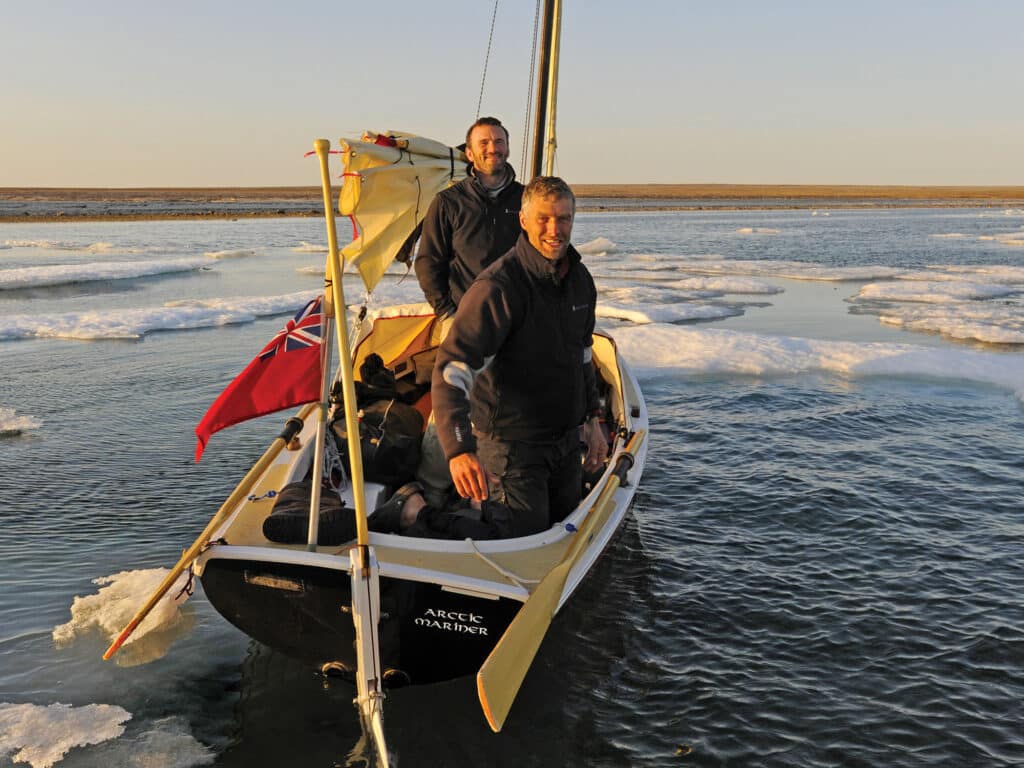
We were approaching the trickiest, most hazardous stretch of the Northwest Passage, high in the Canadian Arctic, when we happened upon a sight more wondrous in its own way than all the ice, polar bears and other assorted wildlife that preceded it. Tucked up against a barren shoreline, its anchor embedded in a handy ice floe, was a nifty little trailer-sailer, what we soon discovered was a NorseBoat 17.5 Classic.
Hopping in the dinghy from our rather cushy 64-foot steel cutter, we pulled alongside and were greeted by a pair of strapping Royal Marines named Kevin Oliver and Tony Lancaster. They were on military leave for a busman’s holiday of sorts: sailing, rowing and occasionally dragging their open boat, with a simple cuddy for accommodations, through the notoriously challenging high northern latitudes. One thing was clear: If these dudes were running the British Empire, there’d still be one.
Those chaps, and that boat, captured my imagination. I thought about them again late last fall on a road trip from New England to Florida with my daughter as we passed one compact camper after another. We both love camping, and we were debating the merits of one mini Gulf Stream to another tiny Winnebago when she said something profound: “Why not have a trailerable sailboat as your RV? You could sleep in it while traveling, then when you reached your destination, you could go sailing.” Why not indeed?
I’ve owned many fully found, systems-rich cruising boats but have always been enamored with the simplicity and versatility of something small and trailerable that you could tow and launch from just about anywhere: the Florida Keys, the coast of Maine, the Sea of Cortez, the Pacific Northwest. (The closest I’ve personally come is a J/24, which can be trailered anywhere, but which is more of a dedicated racer than a pocket cruiser.) There’s something seriously appealing about the idea. Which is why, over the years, I’ve kept a short list of the boats I think could fill the bill, having sailed them to test their potential. What follows are a few of my favorites.
– TOW LIKE A PRO –
Safety Tip Provided by the U.S. Coast Guard
Remember to leave extra stopping room when trailering your boat. At the ramp, be considerate of others but take the time you need to launch and recover your boat safely. Always check tie-downs, safety chains, lights – and the drain plug.
For the Hearty at Heart
I’ll always relate to those hardened Brit lads in the Arctic when I think of the NorseBoat 17.5 Classic. (Perhaps to underscore their no-nonsense attitude, they co-authored a book about their adventure entitled—what else?—Blokes Up North.) The boat’s Canadian builder has an appropriate nickname for its vessels, which include 12.5 and 21.5 models: the “Swiss Army knife of boats.” The 17.5 Classic is one salty-looking craft, with a pronounced bow, sweeping sheerline, lapstrake fiberglass hull, pivoting carbon-fiber gaff-rigged spar, fully battened mainsail, kick-up rudder, and a pair of rowing stations with a set of 9-foot oars. Options include a full-size tent that encapsulates the entire open boat, though the cuddy works well for most outings, and motor mounts for a 2 or 4 hp outboard. Talk about distinctive. NorseBoat says that the boat can be towed by a midsize car, fits in a standard garage, and is ideal for “cruising sailors who want to downsize, sea kayakers who are moving up, and daysailors who want a high-performance boat with lovely traditional lines.” I agree with that assessment. It will also work, ahem, for grizzled soldiers looking for a “relaxing” break from the front lines. norseboat.com
The Trailerable “Legend”
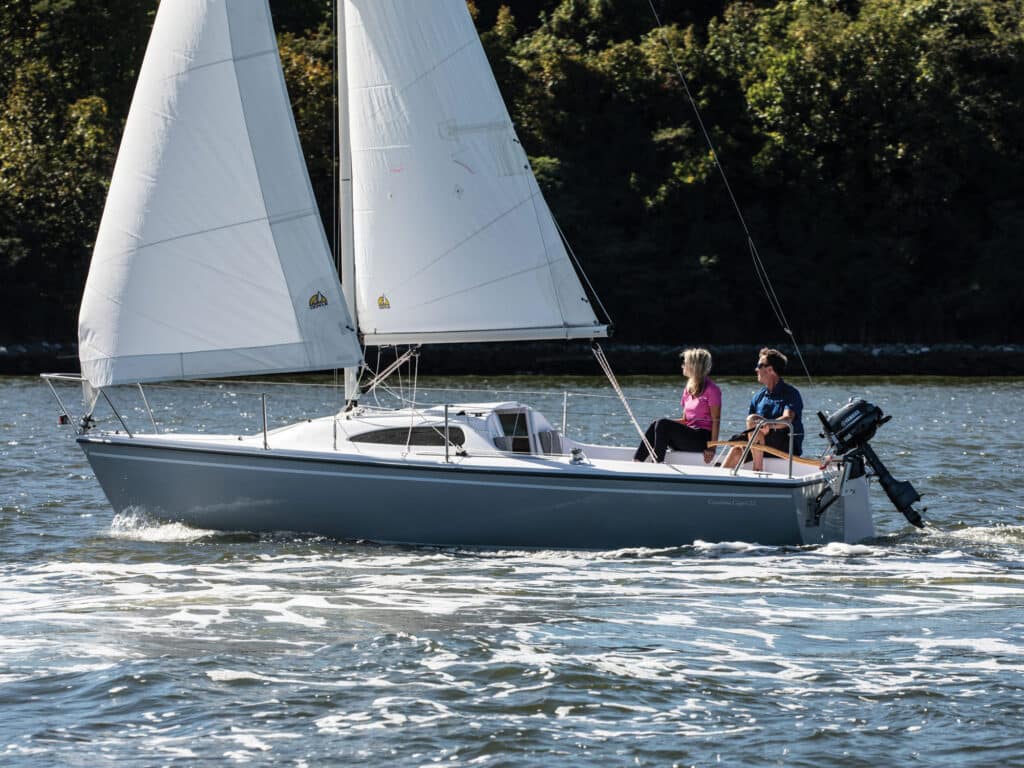
My lasting memory of the Catalina 22 is a visit I paid to the Southern California plant where they were built some four decades ago. From a balcony overlooking the factory floor, I saw four production lines knocking out the classic little 22-footer, each line producing a boat per day (another facility on the East Coast also churned out one daily). It was the Golden Age of American boatbuilding, and I’ve always considered this compact craft to be the gold standard of trailerables (longtime Catalina designer Gerry Douglas prefers to call it “the Miller Genuine Draft of sailboats: cheap and cheerful”). Seeing that almost 16,000 have been launched over the years, “ubiquitous” also works. The early models were bare bones: no winches, lifelines, nothing. But over the years, Douglas says, “the options grew, and it morphed into a cruiser,” with galleys, heads, holding tanks and other accoutrements. The trouble with all the stuff was that many sailors liked racing their 22s, and the extra gear made the boats heavier and noncompetitive. Douglas eventually went back to the drawing board and designed a lighter version, the Catalina 22 Sport. It was competitive with the older, original boats—and is still produced today. “If you opened up a dictionary with a picture of a sailboat, it would be the Catalina 22,” Douglas says. “I think it has a place in the history of our sport. It was simple, with no bad habits. It introduced a lot of people to sailing and provided a lot of pleasure over the years.” And continues to do so. I’ll take one anytime. catalinayachts.com
Fast and Fun
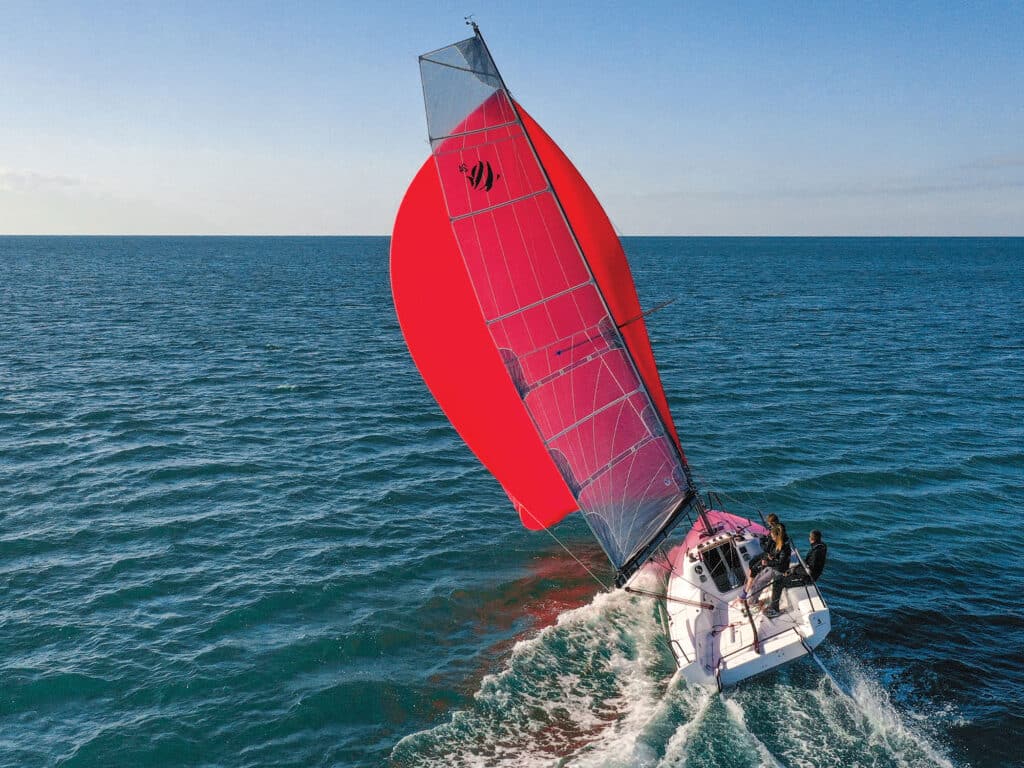
My first exposure to the Seascape line of quick and trim racers/cruisers—a brand built and launched from Slovenia, which is a rather sailing-crazed nation—came from my colleagues at our sister publication Sailing World, a dedicated racing magazine. They raved about the quality of construction and sailing experience. Then, in 2018, Seascape was acquired by Groupe Beneteau, and all previous Seascape models were integrated into the Beneteau First product range. It provided the line with the sort of widespread, mainstream marketing punch that it deserved. I’ve since sailed a pair of larger models produced by their collaborative effort, but if I were inclined to go the trailer-sailer route, my choice would definitely be the Beneteau First 24 SE (the SE standing for Seascape Edition). It’s a high-tech version of the previous First 24 with a serious boost in performance. The SE line’s sweet spot, in the company’s own assessment, is as a dual-threat boat aimed at competitive one-design racing and adventure sailing. I reckon that 24 feet is an ideal size for both, and the 24SE delivers on the promise with a carbon rig; swing keel with lead bulb; laminate sails; and light, high-tech, infused-vinylester construction. With removable crew bags and modular components that can also be stored ashore when racing, the 24 SE can be set up quickly and easily for cruising or competition. beneteau.com
– LEARN THE NAVIGATION RULES –
Safety Tip Provided by the U.S. Coast Guard
Know the “Rules of the Road” that govern all boat traffic. Be courteous and never assume other boaters can see you.
One Sharp Sharpie
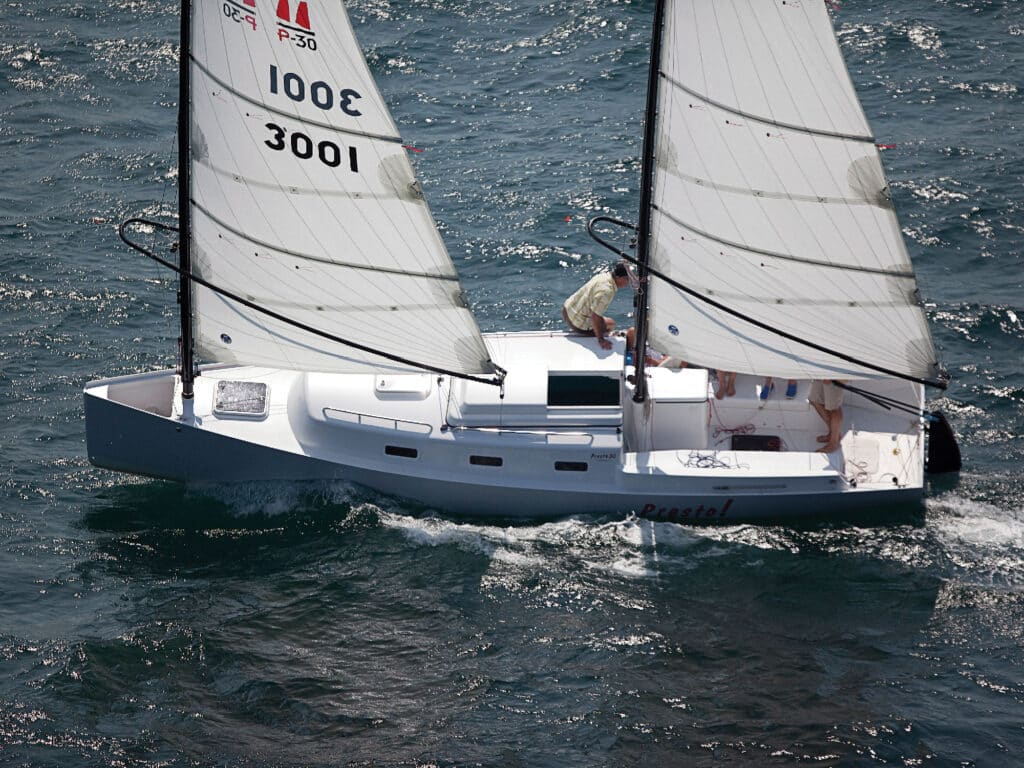
The late Rodger Martin was a South Africa-born naval architect who is probably best known for the robust round-the-world racers he conceived for solo legend Mike Plant, which is when I first met him. Tellingly, however, when it came to designing his own personal boat, he produced the very cool Presto 30. The 30-footer was an offshoot of the Outward Bound Hurricane Island 30 that he designed for the wilderness program based in Maine, but that was a hybrid sailing/rowing boat. To upgrade it for cruising, Martin basically designed a sharpie, based on the straight-sided 18th-century fishing boats with a hard chine, flat bottom and centerboard for access to shallow water. With a beam of 8 feet, 6 inches, the boat is eminently trailerable, and Martin regularly towed it south from New England in the wintertime for cruising forays across the Gulf Stream and into the Bahamas. Due to that shallow draft and minimal freeboard, the rig required a low center of effort, which Martin addressed with a simple cat-ketch rig. With the addition of a slightly raised cabin top, he was able to insert basic interior accommodations (which were also somewhat compromised by the centerboard trunk). For a couple who can embrace camper-style cruising, however, it fit the bill. In recent years, a couple of Presto fans have tried to put the boat back into production, which has yet to happen. But if you can find a used one, you’ll have a boat with a fine and unusual pedigree. rodgermartindesign.com
An Upgraded Ensign
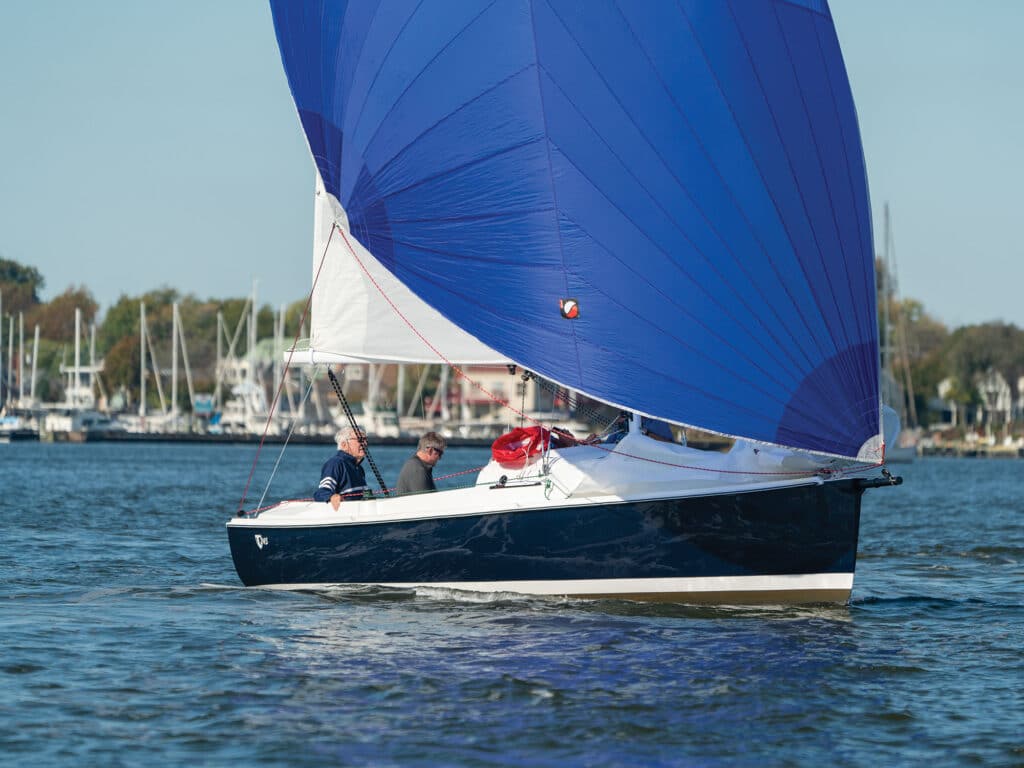
A couple of years ago, I got myself a 1963 Pearson Ensign, a venerable daysailer designed by the great Carl Alberg that measures in at a smidgen under 23 feet with a full keel and a spacious cockpit. I quite enjoy my Ensign, but designer Tim Jackett has taken some of the ancient classic’s best features and incorporated them into a thoroughly modern upgrade: the Tartan 245. Conceived as an ideal tool for teaching sailing, the 245 replaces that massive keel with a lifting one that has 900 pounds of ballast, which makes it just as stiff as the old-timer. With the board down, it draws 4 feet, 6 inches, but once raised, the draft is just 1 foot, 8 inches—and with its kick-up rudder, you can nudge into the shallows that the Ensign could only dream about. Like the full-size members of the Tartan clan, the 245 has a carbon-fiber spar that’s stepped on deck and is easily raised and lowered. A retractable bowsprit is ideal for flying off-wind reachers; for working sail, there’s a choice of an overlapping headsail or a self-tacking jib. The little cuddy space forward is another feature reminiscent of the Ensign; it can be employed, along with the handy tiller, for camper-style cruising. You may be able to have more kicks on a little sailboat, but I’m not sure how. tartanyachts.com
– LOWER YOUR RATES –
Safety Tip Provided by the U.S. Coast Guard
Taking a boating safety course won’t just make you a better skipper. It could also help you save big on insurance.
Happy Little Girl
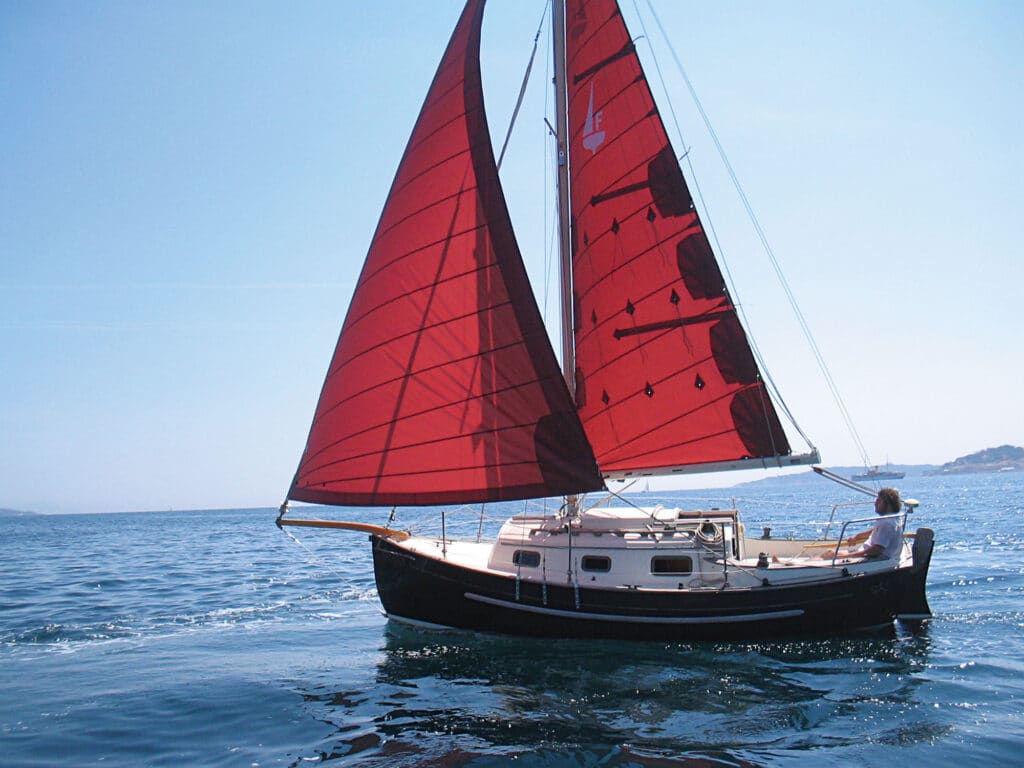
And now for something completely different: the Pacific Seacraft Flicka (Swedish for “happy little girl”). It’s a 20-foot, heavy-displacement, full-keel pocket cruiser that, yes, you can pop on a trailer and wheel to destinations of your heart’s content. Designed by Bruce Bingham—an illustrator and sailor who, for many years, penned this magazine’s Workbench column—the boat was originally offered in kit form, and then bounced around to a couple of builders before finding a permanent home at Pacific Seacraft, which produced the grand majority of them (reportedly, roughly 400 Flickas were ultimately produced). Bingham loved his, sailing his pretty Sabrina all over creation, which is when I became enamored with the boat. The Flicka certainly fits the definition of a cult boat, and these days, if you look hard enough, you can find one in almost any configuration: sloop, cutter, yawl, schooner, even gaff-rigged. With a startlingly roomy interior, the Flicka is cozy but certainly not the fastest 20-footer you can find. You might not get where you’re going quickly, but you will get there. flicka20.com
To the Third Power
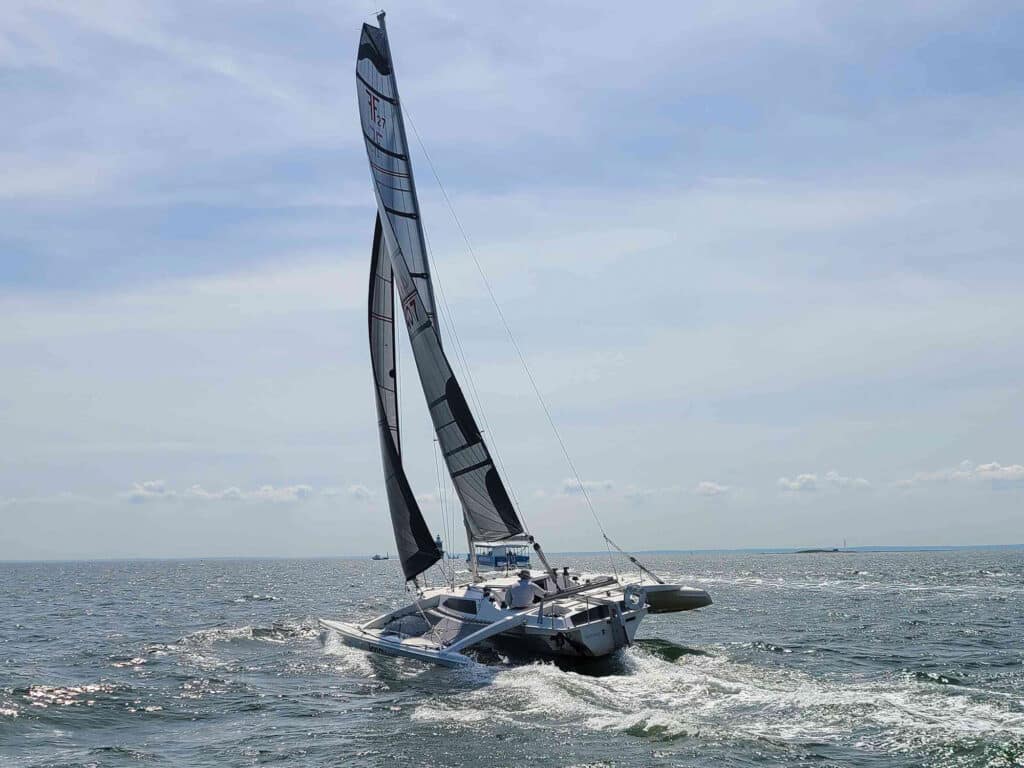
Talk about a boat that was ahead of its time. Any list of good trailerable boats has to include a multihull, and few have reached the overall popularity of the Corsair F-27, the prototype for which was originally launched way back in 1985. It’s designed by Kiwi Ian Farrier, based on another little trimaran he’d created a decade earlier. The signature feature of the three-hulled 27-footer is the folding outrigger system—better known as the Farrier Folding System—which reduces the beam from a significant 19 feet to a mere 8 feet, 2 inches, which makes it eminently trailerable. You can still see (and find) F-27s just about everywhere. They have active one-design racing fleets all over the place, and they make for tidy pocket cruisers when they’re not zipping around the racecourse. From a pure sailing point of view, there’s nothing more enjoyable than finding yourself perched out on an ama of an F-27, coursing along at double-digit boatspeeds, with a light touch on a long tiller extension. We’re talking joy, cubed. corsairmarine.com








